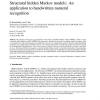Free Online Productivity Tools
i2Speak
i2Symbol
i2OCR
iTex2Img
iWeb2Print
iWeb2Shot
i2Type
iPdf2Split
iPdf2Merge
i2Bopomofo
i2Arabic
i2Style
i2Image
i2PDF
iLatex2Rtf
Sci2ools
130
click to vote
IDA
2006
Springer
2006
Springer
Structural hidden Markov models: An application to handwritten numeral recognition
We introduce in this paper a generalization of the widely used hidden Markov models (HMM's), which we name "structural hidden Markov models" (SHMM). Our approach is motivated by the need of modeling complex structures which are encountered in many natural sequences pertaining to areas such as computational molecular biology, speech/handwriting recognition and content-based information retrieval. We consider observations as strings that produce the structures derived by an unsupervised learning process. These observations are related in the sense they all contribute to produce a particular structure. Four basic problems are assigned to a structural hidden Markov model: (1) probability evaluation, (2) state decoding, (3) structural decoding, and (4) parameter re-estimation. We have applied our methodology to recognize handwritten numerals. The results reported in this application show that the structural hidden Markov model outperforms the traditional hidden Markov model w...
Computational Molecular Biology | Hidden Markov Model | IDA 2006 | Information Technology | Structural Hidden Markov |
Related Content
| Added | 12 Dec 2010 |
| Updated | 12 Dec 2010 |
| Type | Journal |
| Year | 2006 |
| Where | IDA |
| Authors | Djamel Bouchaffra, Jun Tan |
Comments (0)

